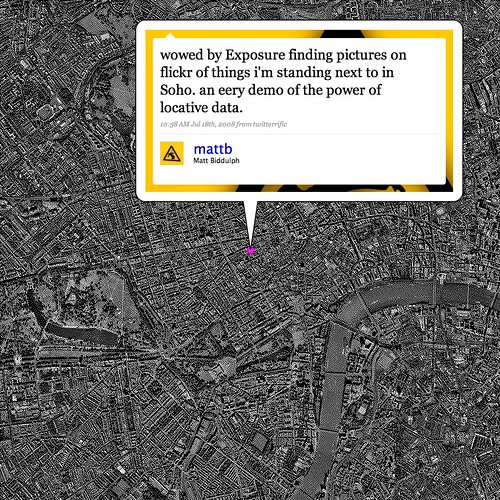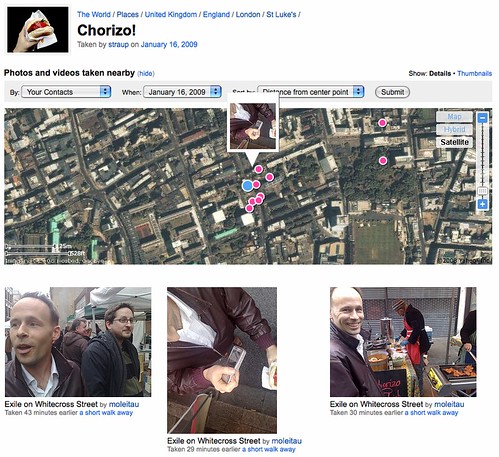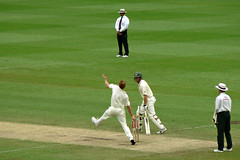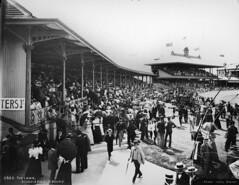“The problem with these geolocative services is that they assume you’re a precise, rational human, behaving as economists expect. No latitude for the unexpected; they’re determined to replace every unnecessary human interaction with the helpful guide in your pocket.”
Back in June of 2008 we added the ability to perform radial queries in the photos.search API method. One of the earliest developers to use this feature was Frasier Speirs who used it for the Near Me
feature of Darkslide, his Flickr application for the iPhone originally named Exposure.
It is difficult to overstate how impressive, and important, tools like Google Earth and PhotoSynth are visualizing geographies and in pushing the boundaries of what is possible both technically and conceptually. But both do so at the expense of what Scott McCloud calls “the magic in the gutter“. On the subject of the gutter, the space between the individual panels in a comic book, McCloud writes:
“From an axe-murderer pursuing a frightened man in one panel to an ambiguous shriek in the next, what happened? You killed a character in your mind. The artist did nothing of the sort. Closure is the work done by a reader which takes two juxtaposed images and unifies them into a single idea.”
That’s one of the things I like the most about “Near Me” and the ability to perform radial queries using the Flickr API: It affords a representation of place spun from a thicker, coarser, yarn. Less precise, maybe, but richer in its own way. With radial queries there is the knowledge that all the photos were taken close to one another — so close in some cases you can almost walk down a city block from one photo to the next — but the results are staggered, often overlapping one another, indoors and outdoors in time and space.
That staggering is the breathing room, the gutter, that lets viewers discover, imagine and create their own connections, their own closures, from not just a one history of a place but also the patterning of all those who’ve passed through it.
“Whether mapping lost lakes of a different era or tracing the edges of disappeared lagoons that still haunt the streets of San Francisco — or reminding urbanites of the sport-fishing possibilities beneath Manhattan — we are alive within laminations we will never fully map or comprehend.”
Earlier last week we enabled a quiet little feature that, hopefully, allows you to navigate some of that same mystery and serendipity in the 100 million geotagged photos on Flickr. We call it “nearby” and it is available for any geotagged photo on the site.
Nearby starts with a geotagged photo and then queries for other geotagged photos within a one kilometer radius. You can order the results by time and distance and interestingness but the important part is that they are photos, well, nearby to the photo you are looking at. Nearby is a deliberately fuzzy concept. Nearby in St. Peter’s Square in Rome might mean the person directly in front of you. Nearby in the streets of a small town might be the beautiful garden behind the fence and around the corner. Nearby encourages people to poke around and discover their surroundings, as though they were on foot and everything was just a short walk away.
For example, I went to London recently and I while I was there the lovely crew at Dopplr took me around the corner from their offices to the Whitecross Street Market for lunch. We oggled the cheese and I had a chorizo sandwich and we all took lots of pictures. This is a picture of my sandwich and these are the photos taken nearby, including one of me taking a picture of my sandwich:
I have no idea what’s up with the creepy smile. I blame… the jet-lag.
If you look carefully at the screenshot above, you can see that I’ve defined “nearby” to mean only photos taken by my contacts on the same day and sorted by their distance from my delicious sandwich. This is a very specific and personal view and its value for me is as a record of a shared experience with friends. But if I strip away all the conditions and visit the default “nearby” page today I can see the snow that’s recently fallen on London and the graffiti that I walked passed, but didn’t photograph, in Shoreditch and Cal hanging out in the Moo/Dopplr offices.
I can watch the place around my photo grow up while also nosing around in the shoebox of its past and, at the same time, someone else can see that I ate a sandwich on Whitecross street.
The default search criteria for nearby is all photos taken in the last month sorted by date taken (most recent, first) but there are lots of different ways to define what nearby looks like using the available filters:
Who took a photo? (For the sake of brevity, “you” can also be taken to mean another photographer.)
- Everyone
- Everyone by you
- Only you
- Only your contacts
When was it taken?
- In the last month
- Today, you know
today
- The day that the photo was taken
- All time
How should those photos be sorted?
- Date taken
- By distance from the center point
- By interestingness
More sophisticated filters, like explicit date ranges, aren’t yet avaliable but we’re definitely thinking about them and we’d love to hear how people would like to use nearby.
The links for nearby pages are currently only available from the modal “map” dialog on individual photo pages or by URL hacking which is really just fancy talk for adding /nearby to the URL of any (geotagged) photo page.

Here’s a picture of another sandwich, this time a Philly Cheesesteak, taken in San Francisco’s Mission district:
http://www.flickr.com/photos/straup/3199232007/
And here are nearby photos:
http://www.flickr.com/photos/straup/3199232007/nearby
Or a photo of the Sydney Cricket Ground, from the Powerhouse Museum’s Collection, taken in 1900:
http://www.flickr.com/photos/powerhouse_museum/3022876525/
And photos taken nearby, on the very same grounds, 100 years later:
http://www.flickr.com/photos/powerhouse_museum/3022876525/nearby?taken=alltime&sort=distance
photos by Tyrrell Photographic Collection, Powerhouse Museum and brettm8
Just like that! Well okay, we added a couple query parameters (to that last link) which most people aren’t ever going to do but you get the idea.
We’ve also added a special page, which you can link to with any old latitude and longitude and and we’ll show you photos near that point. This isn’t a page that we expect people to visit directly (typing all those numbers in the location bar is pretty boring, really) but rather we hope that it will be used by third-party applications and devices which are location aware and can fire up a web browser.
For example, if I were wandering around the Metropolitan Museum of Art, in New York City:
http://www.flickr.com/nearby/40.779274,-73.963265
In the not so distant future, when web browsers are able to read your location using a GPS signal or wifi triangulation then [REDACTED BY KITTENS] but for now this is just a little something to bridge the difference and a hook for people to use in their applications.
In the Easter Egg department we’ve also added support for geohashes to the special “lat, lon” pages. The Wikipedia entry for geohashes describes them as “a hierarchical spatial data structure which subdivides space into buckets of grid shape … offering properties like arbitrary precision and the possibility of gradually removing characters from the end of the code to reduce its size (and gradually lose precision).” They’re also just short(er).

When hashed, 40.779274,-73.963265 becomes dr5ruzts7p8k which is all kinds of weird but that is true of all URL shortening services. Anyway, if the length of your URLs is an issue and the extra 8 characters are really going to make a difference you can sacrifice some of the built-in semantics in the longer version and use the following to link to the same photos from the Met:
http://www.flickr.com/nearby/dr5ruzts7p8k
Finally, during the time its taken me to write this blog post I came across the SnarkMarket blog and a piece quoting Ed Folsom’s account of Walt Whitman’s experience of “urban affection” which I think is a nice ribbon to wrap it all up with:
Whitman feels the power of the city of strangers. He’s looking at a city of strangers and how something we might now call urban affection begins to develop. How do you come to care for people that you have never seen before and that you may never see again?
Every day we encounter people, eyes make contact, we brush by people, physically come into contact with them, and may never see them again.
…
“If I were doing that activity that person would be me. If I were wandering the other way, rather than this way, that person could be me.”
photos by Paul Hammond





